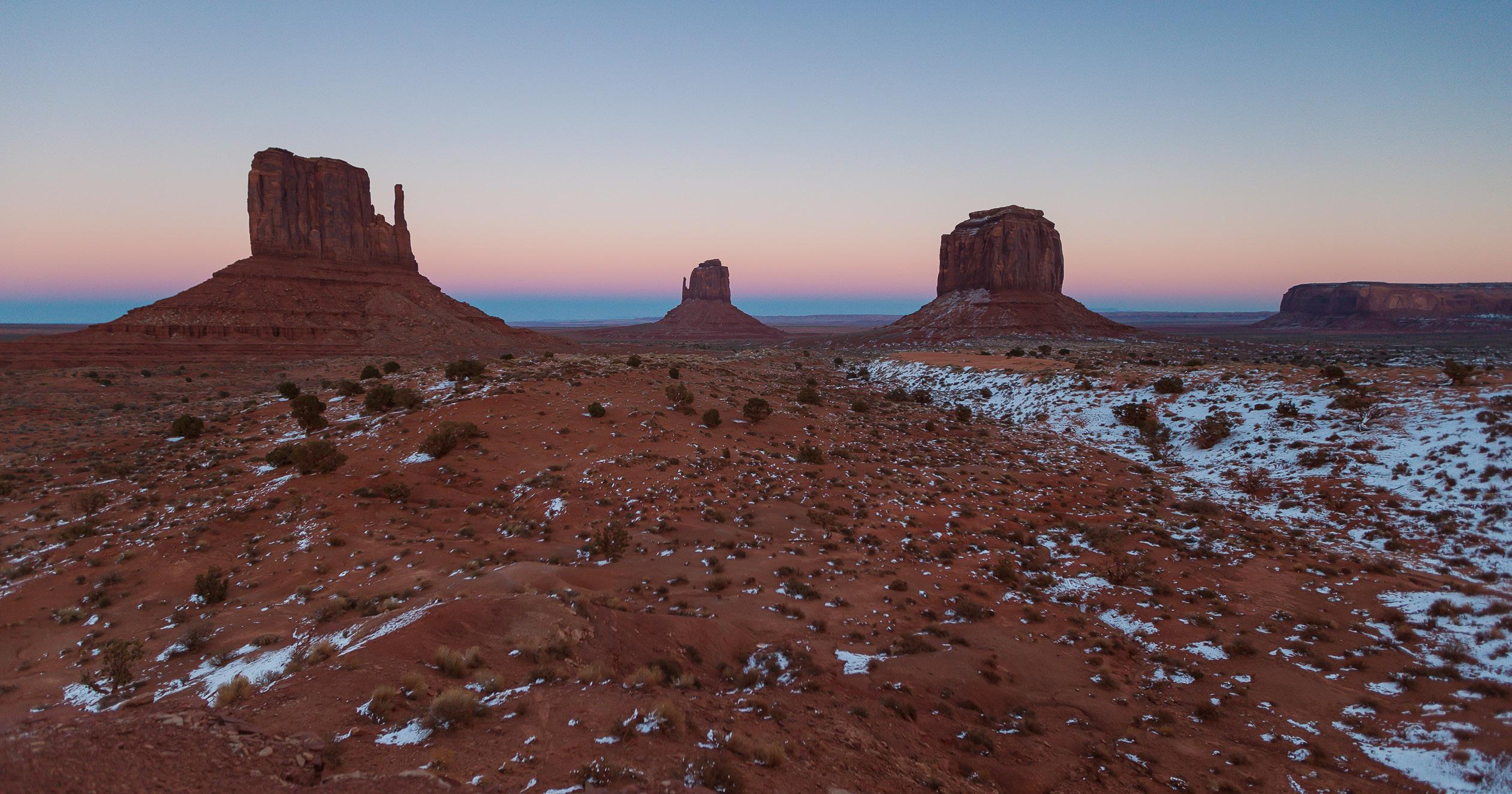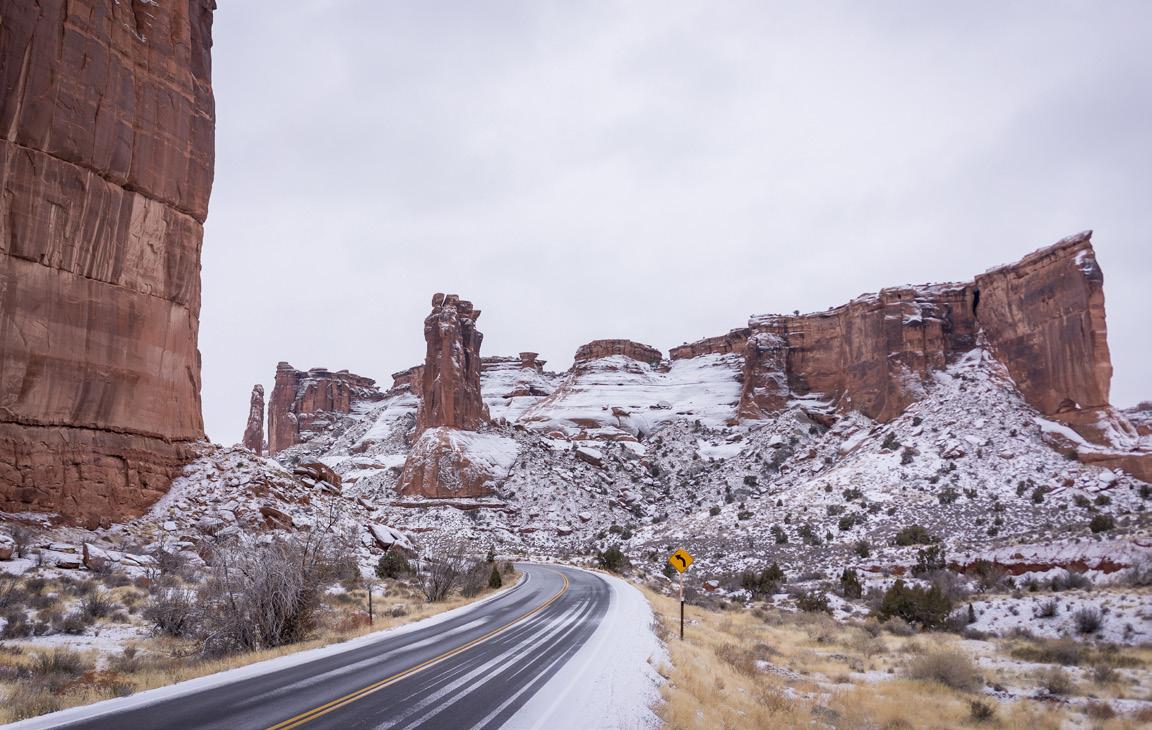
4 minute read
HIDDEN GEMS
Winter is the New Summer With the outdoors being a safe place to play, we might just brave unpredictable weather to explore these popular desert destinations in the winter
STORY BY BRENDA BERGREEN
Snow begins to fall, and you dream of warm beaches and wildflowers. Warm days take over, and you count down to sweatshirt weather and cuddling by the fire. Winter often gets a bad rap for halting our adventures and forcing us inside — unless you’re going skiing, of course. The days are shorter and colder; but instead of wishing them away, it’s time to recognize what it really means. The crowds are smaller, even nonexistent at popular destinations across the Southwest that are typically overrun during the warmer months. In short, you can have a natural wonder all to yourself.
ARCHES NATIONAL PARK
Would you rather be too hot or too cold? Don’t answer that. What we all really want is perfect temperatures, but if this year has taught us anything, it’s that there is a lot we can’t control. Weather has always been one of them. Arches National Park in winter is typically sunny, cool and perfect for a trail run through the park. That was our original plan. What we encountered was clouds, wind and snow. Not only did that mean we wouldn’t get to trail run across the park, but our sunrise photos would be missing one thing: the sunrise.
Snow falls but doesn’t often stay around in this area of Southeast Utah; therefore, rather than be disappointed at the change of plans, it seemed like a good opportunity to photograph the park. Advantages to Arches in winter include a brilliant contrast of snow to red rock and having such views all to yourself.
Getting into Arches in summer and fall can mean a long line of cars. Winter vehicle traffic is somewhere in the ballpark of 250 cars per day versus 2,500 in the peak summer months. To give you an idea of what that means, the parking lot capacity of Arches is exceeded most days in March through October. These warnings can be seen in a graph on Arches website along with traffic tips. In the winter, instead of studying traffic tips, you can focus on seeing the unique rock formations that Arches is known for.
TOROWEAP OVERLOOK - GRAND CANYON NATIONAL PARK
If heading out in winter isn’t enough to escape the crowds, head out to somewhere that’s way way way off the grid. Toroweap Overlook isn’t your standard Grand Canyon overlook that attracts hordes of tourists. It’s a remote spot down a long bumpy road that requires a high clearance vehicle and slow, methodical driving so you don’t pop a tire when you have no one to call.
But if you make it out there, better yet if you get a camping permit, you’ll have the whole Grand Canyon all to yourself — or at least as far as you can see. As you look down 3,000 feet to the Colorado River, you’ll wonder why you ever thought you had any problems. Getting off the grid has that effect. Seeing the size of the Grand Canyon does that to a person. And isn’t that what we all need this year?
The solitude of Toroweap Overlook at sunrise. photo by Marc Bergreen.
MONUMENT VALLEY TRIBAL PARK - TSE’BII’NDZISGAII
If you’re looking for something a little less rugged, drive the road through Monument Valley Tribal Park. You can stay in the warmth of your car and view the vistas of one of the most heavily photographed places in the Southwest. It doesn’t take long to understand why. Wind and water have eroded the plateau to reveal breathtaking sandstone buttes.
There is a daily entry fee to the park. You can also opt to hire a Navajo Guide for a narrated tour. Monument Valley Tribal park is protected by Navajo Nation Parks and Recreation which protects the Little Colorado River, Antelope Canyon, Monument Valley, Four Corners, Canyon de Chelly – Campground, Bowl Canyon and the Navajo Veterans Memorial Park. If traveling to one of these areas, please heed the request of Navajo Nation Parks and Recreation to keep our Mother Earth clean.
Navajo Nation Tribal Parks closed during the pandemic, see their website before planning a visit.
Trails are more crowded now that the outdoors is a safer place to be. Many adventurers are discovering or rediscovering our beautiful landscapes. It’s the hope of many that with that renewed love of lifechanging landscapes and breathtaking views will come a commitment to protect, honor and treat these places with respect.
BRENDA BERGREEN is a storyteller and photographer living in Evergreen, Colorado, with her family. She loves the search for hidden gems and is willing to brave cold weather to have epic landscapes all to herself.
Monument Valley at sunset with a sprinkle of snow. photo by Marc Bergreen.

The author enjoying a hot coffee clad in long underwear and a puffy jacket. photo by Marc Bergreen.

Driving through Arches National Park on a cold winter morning. photo by Brenda Bergreen











